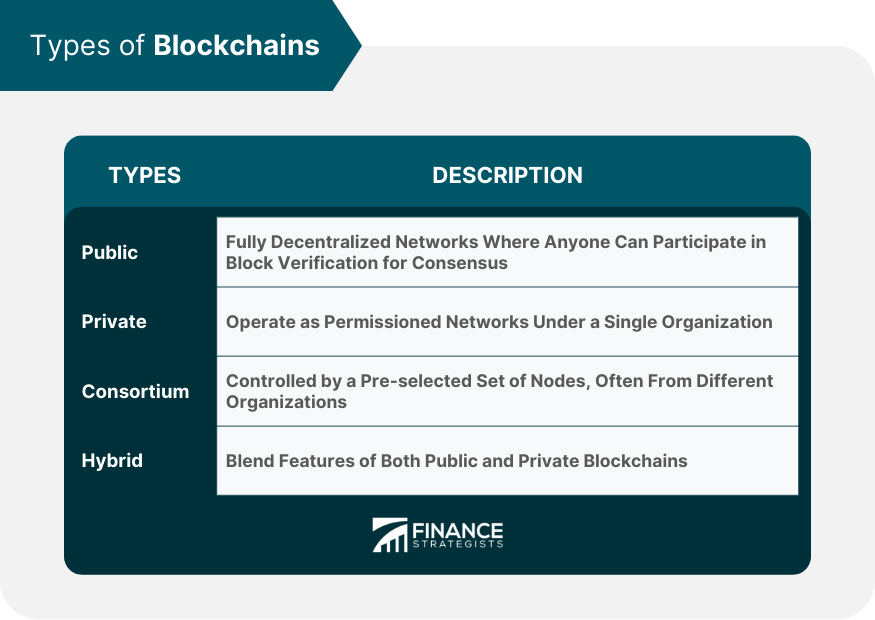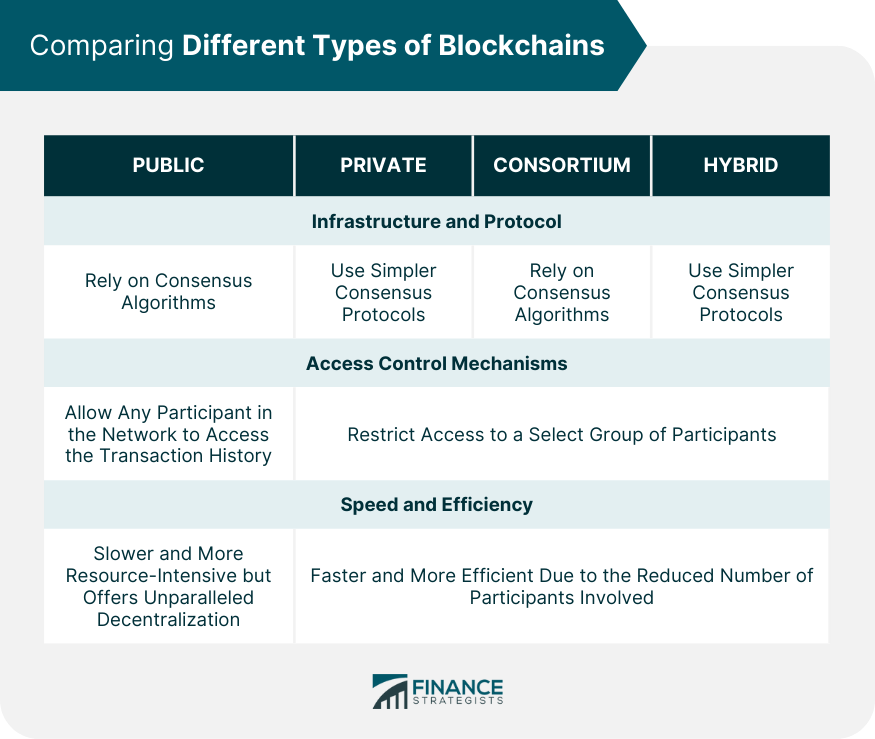Blockchains are decentralized digital ledgers that store records of transactions across multiple computers. They are designed to be transparent, secure, and tamper-resistant, making them a popular technology for various applications, particularly in the realm of cryptocurrencies. At their core, blockchains consist of a chain of blocks, where each block contains a list of transactions. These blocks are linked together using cryptographic hashes, creating an immutable and transparent record of all the transactions that have occurred on the network. There are four main types of blockchains: public, private, consortium, and hybrid. It's important to note that the categorization of blockchains into these types is not always black and white, and there can be variations or combinations that blur the boundaries between these classifications. Furthermore, the blockchain ecosystem is continuously evolving, and new approaches and consensus mechanisms are being explored to address scalability, energy efficiency, and other challenges. Bitcoin and Ethereum, are fully decentralized networks where anyone can join and participate in the process of block verification to create consensus. They are completely transparent as every transaction is public and can be audited by anyone. In contrast, operate under the permissioned networks where the network authority is held by a single organization. They are faster and more efficient as they avoid the complex consensus protocol. Also known as federated blockchains, are partially private blockchains where the consensus process is controlled by a pre-selected set of nodes. This could be a group of companies or representative nodes of several organizations. Blend the features of both public and private blockchains. They allow for customizable access, offering a balance between transparency and privacy. Public and consortium blockchains rely on consensus algorithms like Proof of Work (PoW) or Proof of Stake (PoS) to validate transactions, while private and hybrid blockchains use simpler consensus protocols due to their permissioned nature. Public blockchains allow any participant in the network to access the transaction history, whereas private, consortium, and hybrid blockchains restrict access to a select group of participants. Private, consortium, and hybrid blockchains are generally faster and more efficient due to the reduced number of participants involved in the validation of transactions. Public blockchains, while offering unparalleled decentralization, can be slower and more resource-intensive. With full transparency in Public Blockchains, anyone can verify the transactions, fostering a trustless environment that's resistant to censorship. This is what makes public blockchains like Bitcoin and Ethereum the foundation of cryptocurrencies and decentralized finance (DeFi) platforms. Private blockchains operate within a single organization with restricted access, they bypass the time-consuming consensus protocols of public blockchains. This feature is particularly beneficial for B2B applications where privacy, speed, and control over data are paramount. Consortium Blockchains are controlled by a pre-selected group of nodes, often involving multiple organizations. This setup enables the sharing of a blockchain among trusted participants, making consortium blockchains ideal for inter-organizational collaborations like supply chain traceability or interbank transactions. Hybrid Blockchains blend the features of public and private blockchains, allowing entities to customize their access, control, and transparency levels as per their needs. They are flexible and adaptable, making them a suitable choice for organizations that need a tailored blockchain solution. Public Blockchains like Bitcoin and Ethereum, are characterized by their transparency and decentralization. The consensus mechanisms they employ, such as Proof of Work, require significant computational power and energy, making them slow and resource-intensive. Additionally, the pseudonymous nature of these blockchains can potentially be exploited for illicit activities. Private Blockchains, while lauded for their speed and efficiency. This control over the network can raise questions about data manipulation and authenticity. Furthermore, their closed-off nature could limit network effects, reducing opportunities for innovation. Consortium Blockchains, which strike a balance between public and private blockchains, come with their own set of challenges. Requiring substantial coordination among the pre-selected nodes. This setup can sometimes lead to slower decision-making processes. Hybrid Blockchains, although offering a flexible approach with customizable features, face potential difficulties in implementation. The blend of both public and private features might require more sophisticated management and robust security measures to ensure network integrity and prevent unauthorized access. Due to their open nature, are often employed in the creation of cryptocurrencies such as Bitcoin and Ethereum. Their high level of transparency and security makes them ideal for decentralized finance (DeFi), serving as platforms for decentralized applications (DApps) and smart contracts. Private blockchains are commonly utilized in business environments and inter-organizational processes. They offer a fast and efficient way to record and verify transactions, providing a reliable system for supply chain management, interbank transactions, and patient health records, to name a few. Consortium blockchains provide a middle ground between private and public blockchains. They find substantial usage in tasks that require collaboration between different organizations, such as cross-border payments and shared governance. Hybrid blockchains, with their customizable features, find application in a wide array of sectors. They are useful wherever there is a need for both transparency and privacy, such as in the legal sector for smart contracts, voting systems, and more. Public blockchains, being the most transparent and secure, form the backbone of DeFi, providing platforms for DApps and smart contracts. Private and consortium blockchains can bring efficiencies in traditional banking and financial systems. Hybrid blockchains can cater to more specific use cases, offering tailored financial solutions. Blockchain technology, in its varying forms—public, private, consortium, and hybrid—caters to distinct needs across numerous sectors. Public blockchains, through their unparalleled transparency and security, form the bedrock of cryptocurrencies and DeFi. Private blockchains are tailored for efficiency and control, finding their niche in B2B applications. Consortium blockchains balance between control and transparency, making them ideal for inter-organizational collaborations. Hybrid blockchains, with their customizable features, can be tailored to suit specific organizational requirements. These types are not without their challenges, including scalability issues, energy consumption, and setup complexity. Nevertheless, the diverse applications of these different types of blockchains underscore their potential to revolutionize fields as varied as finance, supply chain, healthcare, and government services, paving the way for a more decentralized future.What Are Blockchains?
Types of Blockchains
Public Blockchains
Private Blockchains
Consortium Blockchains
Hybrid Blockchains

Comparing Different Types of Blockchains
Infrastructure and Protocol
Access Control Mechanisms
Speed and Efficiency

Benefits of the Different Types of Blockchains
Security and Robustness
Efficiency and Speed
Balance Between the Transparency
Best of Both Worlds
Risks of the Different Types of Blockchains
Issues With Speed and Scalability
Risk Becoming Overly Centralized
Complex to Establish and Manage
Potential Difficulties in Implementation
Applications of the Different Types of Blockchains
Public Blockchains
Private Blockchains
Consortium Blockchains
Hybrid Blockchains
Role of the Different Types of Blockchains in Decentralized Finance (DeFi)
Conclusion
Types of Blockchains FAQs
The four main types of blockchains are public, private, consortium, and hybrid blockchains. Public blockchains are fully decentralized and allow anyone to participate. Private blockchains are permissioned and controlled by a single organization. Consortium blockchains involve a pre-selected group of nodes, often from multiple organizations. Hybrid blockchains combine elements of public and private blockchains, allowing for customizable access.
Different types of blockchains work based on their structure. Public blockchains work by allowing anyone to participate in the verification process and are fully transparent. Private blockchains, on the other hand, limit participation to specific entities and use a simplified consensus protocol. Consortium blockchains involve a pre-selected set of nodes in the consensus process. Hybrid blockchains are customizable and allow entities to choose their level of transparency and control.
Bitcoin and Ethereum are examples of public blockchains. Hyperledger Fabric and Corda are examples of private blockchains. Ripple operates as a consortium blockchain. Dragonchain is an example of a hybrid blockchain.
The benefits and drawbacks of different types of blockchains vary. Public blockchains offer robust security and transparency but can be slow and consume a lot of energy. Private blockchains are fast and efficient but lack the same level of transparency and are prone to centralization. Consortium blockchains balance control and transparency but can be complex to manage. Hybrid blockchains are customizable, but this might require more sophisticated management and security measures.
Public blockchains form the backbone of DeFi, providing platforms for decentralized applications (DApps) and smart contracts. Private and consortium blockchains bring efficiencies in traditional banking and financial systems, while hybrid blockchains offer tailored solutions depending on the requirements of the organization or system.
True Tamplin is a published author, public speaker, CEO of UpDigital, and founder of Finance Strategists.
True is a Certified Educator in Personal Finance (CEPF®), author of The Handy Financial Ratios Guide, a member of the Society for Advancing Business Editing and Writing, contributes to his financial education site, Finance Strategists, and has spoken to various financial communities such as the CFA Institute, as well as university students like his Alma mater, Biola University, where he received a bachelor of science in business and data analytics.
To learn more about True, visit his personal website or view his author profiles on Amazon, Nasdaq and Forbes.











